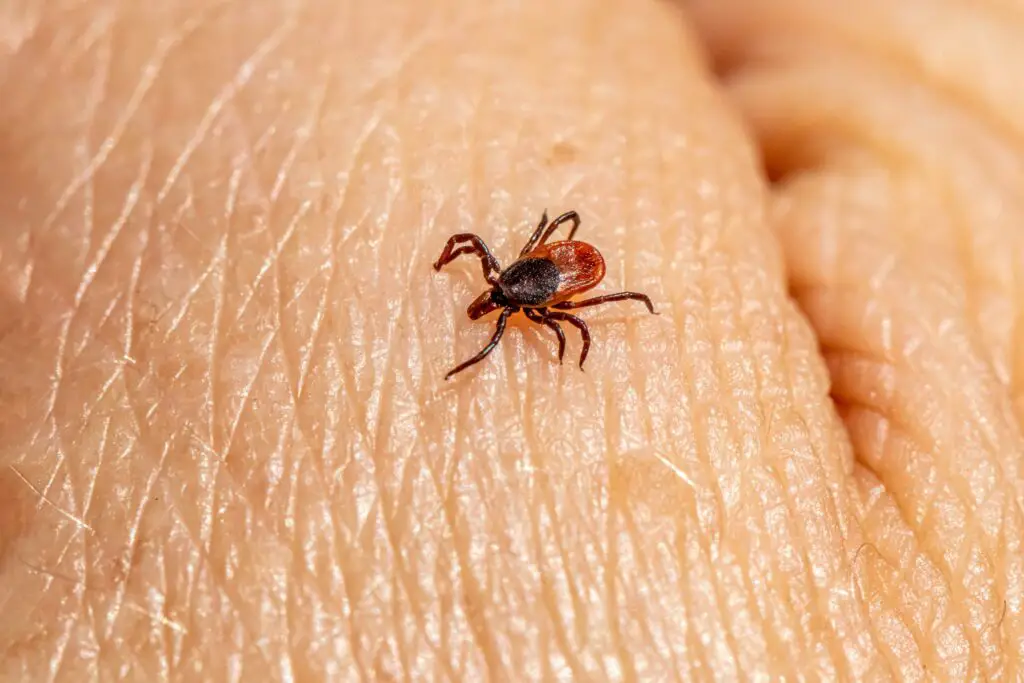Nature is the home to an incredibly versatile array of species, but ticks are definitely one of those that we tend to avoid at all costs.
These tiny arachnids, that are related to spiders, mites, and scorpions, are in fact parasites that survive by attaching themselves to larger animals and feeding on their blood. Humans aren’t spared either. Sadly, these insects carry harmful bacteria that can spread disease to people.
Sadly, tick-borne diseases are at an all-time high, with about 50,000 cases reported each year, and far more going unreported.

There are different types of ticks, and unfortunately, they sometimes find their way to people’s homes. The types most commonly found in homes are the black-legged tick, the dog tick, and the brown dog tick.
- Black-legged Ticks – known as deer ticks, these ticks are typically brown or black in color and have a flattened, oval-shaped body. They are commonly found in wooded areas and can transmit Lyme disease.
- Dog Ticks are larger and can range in color from brown to reddish-brown. They have a tough, shield-shaped body. Dog ticks can transmit diseases such as Rocky Mountain spotted fever.
- Brown Dog Ticks are brown in color and have a slender body.
Although the tick season is between March and October, or sometimes longer, we should be wary of this insects all year round. In fact,if beaten by a tick, a person can develop symptoms even after two or three months.

The bite itself isn’t painful and can cause swelling, itchiness, blistering, and bruising. The bad thing is that ticks also carry and transmit severe diseases, most commonly Lyme disease, as well as Rocky Mountain spotted fever, ehrlichiosis, and babesiosis.
Initially, Lyme disease develops as a circular red ‘bull’s eye’ rash around the site of a tick bite. However, not everyone gets a rash and you should also watch out for a flu-like illness with fever, headache, tiredness and general aches and pains.
The best way to prevent being bitten by a tick is to avoid tall grasses and areas where ticks thrive (such as moorlands and woodlands), especially during the warmer months.
In case you do get bitten, you should remove the tick as soon as possible in order to prevent infections.

These are some of the ways of safe removal.
- Use fine-tipped tweezers: Use clean, fine-tipped tweezers to grasp the tick as close to the skin as possible.
- Pull gently: Apply steady upward pressure, being careful not to squeeze or crush the tick. Aim to remove the tick in one smooth motion without twisting or jerking. Twisting or jerking can cause the tick’s head to break off and stay inside the skin, where it can still transmit disease.
- Clean the area: After removing the tick, clean the affected area with soap and water or an antiseptic solution. Monitor the site of the bite for any signs of infection or a rash, and consult a healthcare professional if necessary.

If by any chance ticks find their way into your home, take immediate action in order to prevent infestation. Most times, ticks are brought into your home in case they stick on your clothes or onto your pets.
- Isolate the area: If you have identified the presence of ticks in a specific area, keep pets and children away from that space.
- Wear protective gear: Put on gloves and a long-sleeved shirt to protect yourself from potential tick bites.
- Clean the area: Clean the area where you found the tick. If it is in bedding, wash the sheets. Inspect the area to ensure there are no more ticks that are present. Dispose of the tick by either flushing it down the toilet or sealing it in a container or ziplock bag before placing it in the trash.
Lucie Arnaz is proud of her ‘15,695 days’ marriage and ‘5 kids’ – she survived famous parents’ horrible divorce
Lucille Ball and Desi Arnaz are perhaps one of the most famous couples in television history. Their romance continued off-screen as well. Their marriage was famously tumultuous, and no one knows that better than their daughter Lucie Arnaz.
Keep reading to know more about their daughter and how her life turned out over the years.

Lucille Ball and Desi Arnaz were perhaps the most beloved couple on American television at one time. Their show I Love Lucy depicted them as the Ricardos, a middle-class couple that were the ideal nuclear family.
The show had six seasons and ran from 1951 to 1957. It followed Lucille as Lucy Ricardo, a housewife who always gets into hilarious situations. While the couple seemed perfect in their on-screen depiction, in real life, their relationship was quite volatile.
The former Broadway star and the Cuban bandleader met while filming Too Many Girls. Their whirlwind six-month romance led to an elopement and marriage in November 1940.

After over a decade of their marriage, the couple became parents to daughter Lucie Arnaz, born on July 17, 1951. Two years after that, on January 19, 1953, they became parents to their second child, their son Desi Arnaz Jr.
The two children joined their parents in the family business of acting. They starred alongside their mother in the spin-off shows for I Love Lucy. Then in May 1961, after nearly two decades together, the couple filed for divorce.
It took years for Lucie Arnaz to open up about the reality of her parents’ marriage and their subsequent divorce. She revealed in a 2018 interview how “They were fighting all the time when we were growing up. There was a lot of anger and screaming.”
She lamented at her childhood where she had to deal with so many issues, she said, “Their divorce was horrible. And then there was the alcoholism. I had preferred those things had never been there. We didn’t have any abuse, but we did go through some pretty hard stuff, and that’s why my parents didn’t stay together. “
Lucille felt the split even more than perhaps her husband because she felt she had shattered the perception the American public had of her. She remarried soon after to comedian Gary Morton.
In her early twenties in 1971, Lucie Arnaz tied the knot to “The Doctors” actor Philip Vandervort Menegaux. The marriage ended in divorce five years later

But the younger Arnaz’s second try at marriage was much more lasting. She met and married actor and writer Laurence Luckinbill. Now the couple has been together for over four decades.
On June 22, 2023, Lucie celebrated her 43rd wedding anniversary with Luckinbill. She took to Instagram to remember the day many decades ago that she was last single on an apple farm in the coastal city of Kingston, New York.
Their friends and family arrived at the venue in a “big yellow school bus.” She was wearing a “lovely cream crocheted gown” as her father walked her down the aisle. She continued in her post, “…[I] vowed to love Laurence Luckinbill till death us do part. 15,695 days, 5 kids, and three grandchildren later, I am proud to still say,’‘ I do.’”
The Murder, She Wrote actress is still very much in love with her husband. She dedicated a sweet post to him on his 88th birthday late last year in November 2022. She posted a picture of him and wrote how he was “kind, talented, adorable, wise, [and] sexy.”
Luckinbill had two children from a previous marriage; Nicholas Luckinbill and Benjamin Luckinbill. And him and Lucie had three more children together; two sons and a daughter.
Their first child together Simon Thomas Luckinbill was born in December 1980, Joseph Henry Luckinbill was born on New Year’s Eve 1982, and their daughter Katharine Desirée Luckinbill was born on January 11, 1985.
Lucie Arnaz and her husband live in Palm Springs, and their family lives nearby. These days the actress wears her hair in a short pixie cut and spends her time with her beloved grandchildren.
On Grandparents Day in 2019, Arnaz joked about hitting the “jackpot” when the couple welcomed their first two grandchildren just four weeks apart from one another. Since then, they have welcomed many more grandchildren to their brood.
Lucie has been a second-generation actor. She was only 11 years old when she starred alongside her mother in The Lucy Show at 11 opposite her mother, which they then followed up with Here’s Lucy.
She also played the main character in the television movie Who Is the Black Dahlia? and also led in the short-lived comedy The Lucie Arnaz Show in 1985 as psychologist Dr. Jane Lucas.
She has played other roles in guest starring parts in shows such as, Marcus Welby, M.D., Murder, She Wrote, Fantasy Island, Law & Order, and the reboot of Will & Grace.
She has also been credited as a producer in three stories related to her parents. Lucy and Desi: A Home Movie, I Love Lucy’s 50th Anniversary Special, and Being the Ricardos. She also produced the 2003 documentary The Desilu Story.
In June 2023 she revealed that she will be doing an encore of her cabaret act titled I Got The Job! Songs From My Musical Past, at 54 Below in New York City. She had performed the show before the pandemic to a sold-out crowd.
While Lucie is very public about her life, her little brother Desi Arnaz Jr. is quite private about his. When Lucille Ball was pregnant with Arnaz Jr, her pregnancy was written into the show. And as fate would have it, she gave birth to him the same day the episode aired in which her character gave birth to ‘Little Ricky.’




Leave a Reply